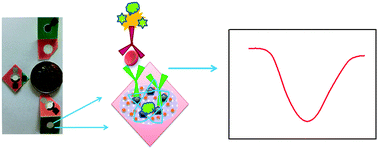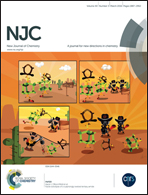A 3D electrochemical immunodevice based on an Au paper electrode and using Au nanoflowers for amplification
Abstract
A highly sensitive electrochemical (EC) immunosensor combined with a 3D origami device for the detection of cancer antigen 125 (CA 125) was developed based on a novel Au nanoparticle-modified paper working electrode (Au-PWE) as sensor platform and Au nanoflowers (AuNFs) as signal amplification label. The microfluidic origami electrochemical device was fabricated by directly screen-printing electrodes on wax-patterned cellulose paper in bulk. The Au-PWE was fabricated using a seed-mediated growth approach and served as an effective matrix for antibody attachment with good bioactivity and stability. Molybdenum disulfide catalyzed the hydrogen peroxide so that the current peak was presented with differential pulse voltammetry (DPV). On the basis of the considerably amplified DPV signal and sandwich-type format, the proposed method successfully fulfilled the highly sensitive detection of CA 125 with a linear range of 0.001 to 50 ng mL−1 and a detection limit of 0.36 pg mL−1. This facile origami EC immunodevice exhibited high sensitivity, specificity and excellent performance in real human serum assay, and it could be applied in point-of-care testing of other tumor markers in remote regions and developing countries.



 Please wait while we load your content...
Please wait while we load your content...